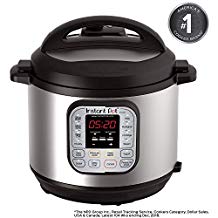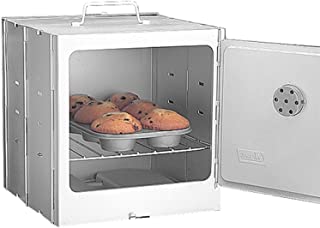Table of Contents
Cookware
stovetop
cast iron
pots
pans
souz vide
FIxmE
pressure cookers
Pressure cookers1) can be extremely useful in a campervan. They can:
- save fuel - because cooking times are often dramatically reduced. Dry beans can be cooked in ~30mins at pressure.
- save water / reduce humidity - a pressure cooker vents less steam than a standard covered pot
- save money on ingredients - even cheap/tough cuts of meat come out tender.
- save time - pressure cook dry beans in about 1/2 hour with no prior soaking
- replace other items - the base can be your large pot. The base + lid can be your covered large pot.2)
Note that since the vessel is pressurized during cooking one cannot easily add ingredients or stir the food while cooking.
Pressure cookers are widely available at thrift shops for very little money. The most common type with a weight3) (“rocker”) to regulate pressure4) is less complicated and more sturdy than the rarer types with dials or gauges. Be sure the thrift store weight-regulated cooker comes with the weight, as they can cost $10 or more. Most used pressure cookers are due for a gasket set, also about $10. Google the model number stamped into the bottom of the cooker to find the correct gasket.
Dial-gauge pressure cookers are not recommended because:
- require regular calibration at an extension service or similar,
- require more attention to cooking temp,5), and;
- the dials are less sturdy than weights in our “rolling earthquakes”.
pressure canning
Pressure canning is one way to get shelf-stable foodstuffs that do not require refrigeration.
If you want to use the pressure vessel for low-acidity (pressure) canning, the National Center for Home Preservation (NCHFP) recommends using a canner that can hold at least 4 quart jars.6)
Canning jars can also do double duty as drinking cups, and the ones marked with measurements can act as measuring cups. Insulated coozies for mason jars can make them easier to handle.
countertop
Countertop cookers run on 110v, whether from shore power or large inverter. Cooking with battery power may require a bank that can handle a lot of current, like lithium or AGM.
rice cookers
Rice cookers are popular in homes but somewhat less popular in vans.
- Rice cookers pull about 300w for 20 minutes or so
- they vent steam continuously
Rice might be better cooked outdoors in a pot, in a pressure cooker, or in a thermos.
crock pots
Crock pots (slow cookers) are functionally similar to rice cookers, but are used for low and slow cooking rather than rapid cooking. For this reason the wattage is (or can be) lower: 75w-250w or so.
A crock pot with removable pot may be easier to clean but is usually heavier and more expensive.
instant pots
 Instant pots are popular with 'dwellers in RV parks or with anyone who has ample power. For example, instant pots are often found where folks are already using induction cooktops instead of propane or who are successfully running microwaves.
Instant pots are popular with 'dwellers in RV parks or with anyone who has ample power. For example, instant pots are often found where folks are already using induction cooktops instead of propane or who are successfully running microwaves.
Instant pots pull 900-1000w on average (over 80A at 12v).
See pressure cookers above for the old fashioned way to cook under pressure.
ovens
solar ovens
Note: there is a separate page for solar ovens
 Solar ovens require no power and are well suited to crockpot-style “low and slow” recipes.
Solar ovens require no power and are well suited to crockpot-style “low and slow” recipes.
folding ovens
 Folding ovens are simple boxes that sit over a heat source and hold heat for baking or other stove-centric cooking.
Folding ovens are simple boxes that sit over a heat source and hold heat for baking or other stove-centric cooking.
They work best on countertop stoves or “suitcase” style camp stoves. They will not balance on top of a narrow “sportster”7) stove and do not like being on broad heat sources like a campfire or BBQ full of briquets. Note: check actual temperatures during a test run because the built in thermometer notoriously reads low. Once you know the offset for your unit you can make mental adjustments.
Common upgrades to even the temperature further: a flame diffuser on the stove or a pizza stone in the bottom of the stove.
misc
foil
Cooking in aluminum foil is a traditional camp cooking technique. Typically it is done by wrapping hamburger meat, onions, and root vegetables in layers of foil and placing in coals.8) Baked potatoes also work well in foil.
thermos
Thermos cooking is a method of saving fuel and dedicated cooking time by finishing cooking in insulated container. Typically the meal is brought to a boil then decanted into the pre-heated thermos.
it's the most useful, cheap and easy cooking technique I've ever seen. I've used it with a variety of thrift store thermos bottles, even a stainless steel [59 cent] coffee pitcher-like affair. Haven't found one yet it didn't work with, and most of these aren't even stainless steel. – josephusminimus9)
Tips:
- use a wide mouth thermos to make cleaning easier
- preheat the thermos with boiling water before use. If you want to ease the thermos into it you can fill it halfway with 1/2 room temperature water then top off with boiling water. After that, preheat with straight boiling water.
- Thermoses10) can be found at thrift stores and garage sales, making for a cheap experiment
- a canning funnel will make filling the thermos easier11)

